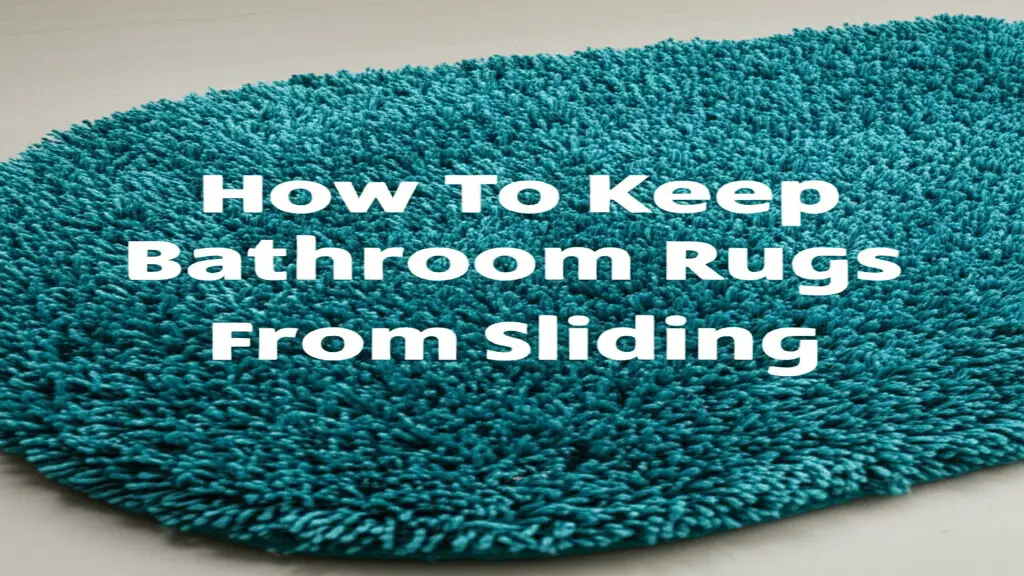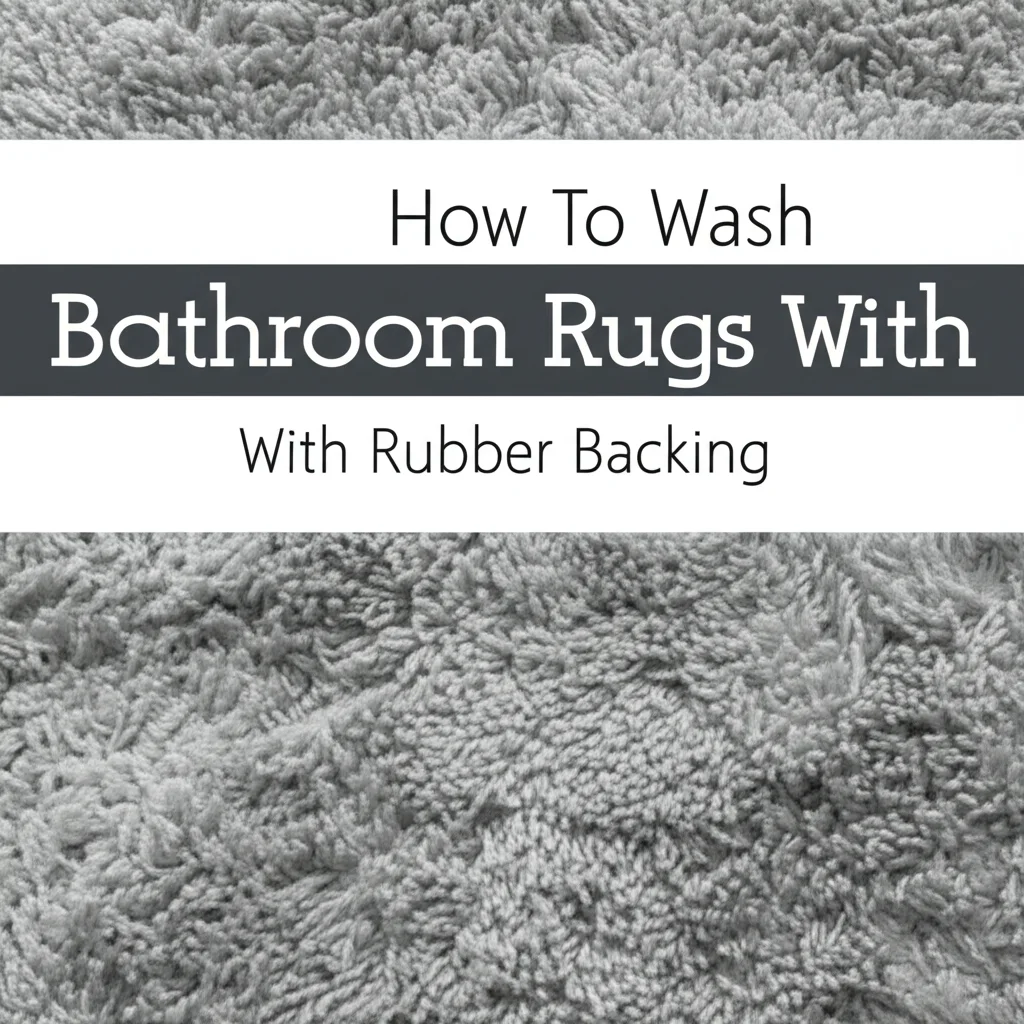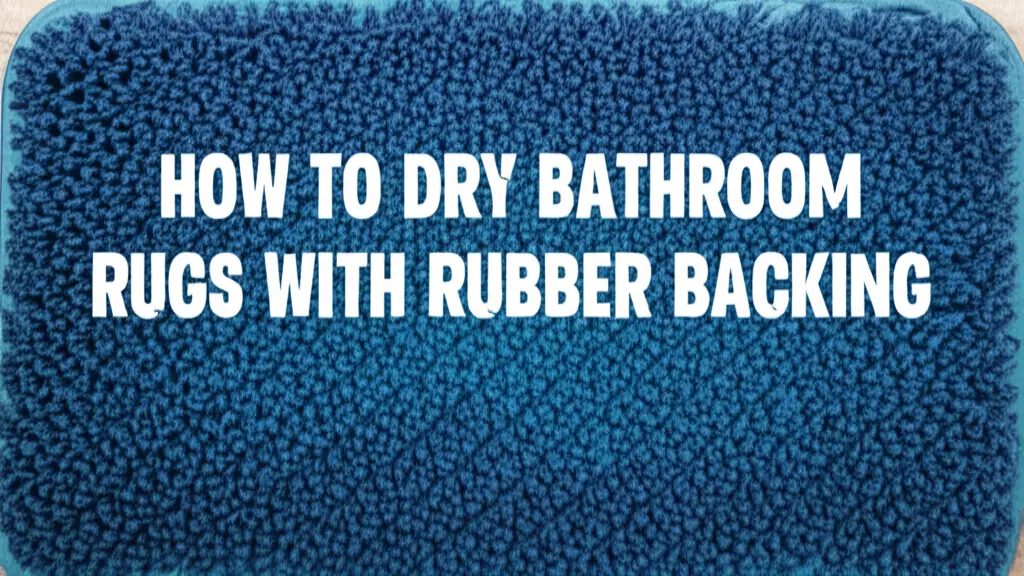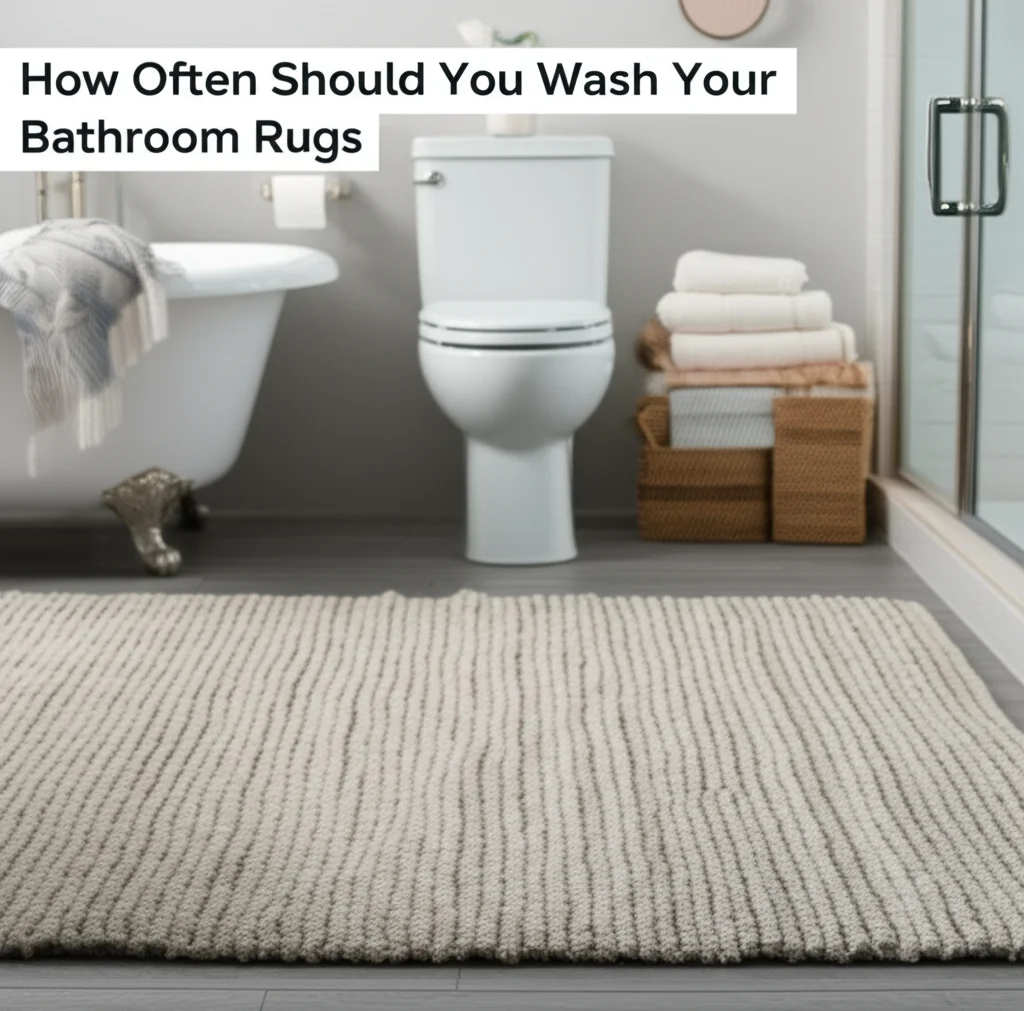· Todd Martin · Bathroom Cleaning · 15 min read
How To Keep Bathroom Rugs From Sliding

How To Keep Bathroom Rugs From Sliding: 9 Effective Solutions
Stepping out of the shower onto a sliding bathroom rug is not just annoying—it’s potentially dangerous. Slipping rugs can cause falls that lead to serious injuries, especially in bathrooms where surfaces are often wet and slippery.
If you’re tired of constantly readjusting your bathroom rugs or worried about safety hazards, you’re not alone. Thousands of homeowners struggle with how to keep bathroom rugs from sliding on tile and other bathroom flooring.
The good news is that there are numerous effective solutions ranging from store-bought products to clever DIY approaches that can put an end to this common household problem once and for all.
Key Takeaways:
- Use rug grippers, non-slip pads, or double-sided tape for immediate solutions
- Apply silicone caulk or hot glue to rug backing for DIY non-slip surfaces
- Choose rugs with built-in rubber backing for inherent stability
- Different flooring types require specific anti-slip approaches
- Regular maintenance extends the effectiveness of non-slip solutions
Quick Answer:
To stop bathroom rugs from sliding, use non-slip rug pads, double-sided carpet tape, rug grippers, or silicone caulk dots on the underside of your rug. For a long-term solution, consider purchasing rugs with built-in rubber backing specifically designed for bathroom use.
Why Bathroom Rugs Slide: Understanding the Problem
Before diving into solutions, it’s important to understand why bathroom rugs slide in the first place. Several factors contribute to this annoying and potentially hazardous problem.
The primary reason bathroom rugs slide is the combination of smooth flooring surfaces and moisture. Tile floors—common in bathrooms for their water resistance and easy cleaning—provide little friction for fabric rugs to grip. When you add water or condensation to this equation, the slipping problem only worsens.
The rug material itself also plays a significant role. Lightweight cotton rugs with smooth backings are particularly prone to sliding. Similarly, synthetic materials can develop a slick underside that glides easily across tile surfaces.
How you use your bathroom matters too. Higher foot traffic areas experience more movement, which gradually pushes rugs out of place. The force of stepping onto a rug when exiting the shower can easily displace it if there’s nothing securing it to the floor.
Even the shape and size of your rug can affect its stability. Smaller rugs have less surface area making contact with the floor, which can make them more prone to movement than larger, heavier alternatives.
Understanding these factors helps explain why a one-size-fits-all solution doesn’t exist. Your specific bathroom conditions—flooring type, humidity levels, rug material, and usage patterns—will determine which anti-slip method works best for your situation.
Store-Bought Solutions for Non-Slip Bathroom Rugs
When it comes to commercial products designed to keep your bathroom rugs in place, there are several effective options available that require minimal effort to implement.
Non-Slip Rug Pads
Non-slip rug pads are perhaps the most popular and widely available solution. These thin, mesh-like pads are placed between your rug and the floor to create friction and prevent movement. Available in various thicknesses and materials, they provide an effective barrier against slippage.
The best non-slip rug pads for bathroom use are made from PVC, rubber, or natural materials like plant-based resins. These materials resist mold and mildew—important qualities in humid bathroom environments. When selecting a rug pad, ensure it’s slightly smaller than your rug so it remains hidden while providing full coverage support.
For tile floors specifically, look for rug pads with higher density that can grip the smooth surface effectively. How to keep rugs from slipping on tile requires special consideration due to the particularly slick nature of ceramic or porcelain surfaces.
Rug Grippers and Tape
Rug grippers come in various forms, including corner grippers and strips that adhere to the underside of your rug. These products use special adhesives to stick to both the floor and the rug, creating a secure connection.
Double-sided carpet tape is another quick solution. This specialized tape features strong adhesive on both sides—one side attaches to the floor while the other grips the rug. When applying rug tape, ensure your floor is clean and dry for maximum adhesion.
The main advantage of grippers and tape is their thin profile, which doesn’t affect the height of your rug or create a tripping hazard at the edges. However, some adhesives may leave residue on certain floor types, so always check product compatibility with your specific flooring material.
Rubberized Spray Products
Rubberized spray coatings can transform ordinary rugs into non-slip versions. These sprays apply a flexible rubber coating to the underside of fabric rugs, creating a grip-enhanced surface.
To apply, turn your rug upside down in a well-ventilated area, clean the backing thoroughly, and spray evenly across the surface. Multiple thin coats work better than one thick application. Allow the spray to dry completely before placing the rug back on your bathroom floor.
While convenient, these sprays typically need reapplication over time as the rubber coating wears off with regular washing and use. They work best as a medium-term solution or for rugs that aren’t washed frequently.
DIY Methods to Prevent Bathroom Rug Slipping
If you prefer a hands-on approach or need an immediate solution with items you likely already have at home, these DIY methods can be remarkably effective at keeping bathroom rugs in place.
Silicone Caulk Technique
One of the most durable DIY solutions involves applying small dots or lines of silicone caulk to the underside of your rug. This creates a permanent, washable non-slip surface that works well on various floor types.
To implement this method:
- Turn your rug upside down on a protected surface
- Apply dime-sized dots of clear silicone caulk in a grid pattern, spacing them 2-3 inches apart
- Allow the caulk to dry completely (usually 24 hours) before placing the rug on your bathroom floor
The beauty of this solution is its longevity—silicone caulk withstands washing and remains effective for months or even years. It’s particularly suitable for bathroom rugs with rubber backing that may have lost some of their grip over time.
Hot Glue Grid Method
Similar to silicone caulk, hot glue can create an effective non-slip backing when applied in a pattern on the underside of your rug. This method provides immediate results since hot glue dries quickly.
For best results:
- Heat your glue gun to the appropriate temperature
- Apply dots or lines of glue in a grid pattern across the entire back of the rug
- Allow the glue to cool completely before flipping the rug over
While hot glue is less durable than silicone caulk and may need to be reapplied after several washes, it provides an excellent immediate solution using a tool many homeowners already have available.
Velcro Strips System
For a removable but secure option, consider installing complementary velcro strips on both your rug and floor. This works particularly well for precisely positioned rugs that you occasionally need to remove for thorough cleaning.
Self-adhesive velcro strips attach easily to most floor surfaces and rug backings. Place the “hook” side on the floor and the “loop” side on the rug, or vice versa. When properly installed, this creates a strong connection that prevents slipping while allowing for easy removal when needed.
The main consideration with this method is potential adhesive residue on your bathroom floor when you eventually remove the velcro. Using removable adhesive varieties can minimize this concern.
Choosing the Right Bathroom Rugs to Minimize Sliding
Sometimes the best solution is prevention through proper rug selection. Certain types of bathroom rugs are inherently less prone to sliding due to their construction and materials.
Rugs with Built-in Rubber Backing
Many bathroom rugs come manufactured with rubberized or latex backing specifically designed to grip bathroom floors. These purpose-built rugs eliminate the need for additional non-slip solutions and often feature washing-machine safe designs.
When shopping for rubber-backed rugs, examine the backing closely for quality and coverage. The best options feature complete rubber coverage rather than just strips or dots. Premium versions use natural rubber rather than synthetic varieties, which typically offer better grip and longevity.
While these rugs eventually lose their non-slip properties over time and with repeated washing, they generally provide excellent stability for 1-2 years of regular use. To extend their lifespan, follow the proper care instructions for washing bathroom rugs with rubber backing.
Heavier Material Options
Heavier rugs naturally resist movement simply due to their weight. Materials like thick cotton, chenille, or microfiber blends offer both absorbency and stability.
Look for bathroom rugs with higher pile density and overall weight. Memory foam bath mats, which have gained popularity for their comfort, also tend to stay in place better than lightweight alternatives due to their density.
The additional benefit of heavier rugs is their superior water absorption, which helps keep your bathroom floor drier and reduces the slipping hazard even further.
Specialized Non-Slip Designs
Some manufacturers have developed innovative rug designs specifically to address the sliding problem. These include:
- Rugs with suction cups that adhere directly to smooth surfaces
- Microsuction technology that creates a vacuum effect on flat floors
- Weighted perimeter designs that keep edges firmly in place
- Interlocking tile mats that create a larger, more stable surface area
These specialized designs typically command higher prices but offer convenient solutions that don’t require any additional products or modifications.
Solutions for Different Flooring Types
Different bathroom flooring materials require specific approaches to prevent rug slippage. What works well on tile might be less effective on vinyl or hardwood.
Ceramic and Porcelain Tile Floors
Ceramic and porcelain tiles are among the most challenging surfaces for keeping rugs in place due to their smooth, non-porous nature. For these surfaces:
- Rug pads made specifically for hard, smooth surfaces offer the best performance
- Silicone-based grippers rather than adhesive types provide better grip without residue
- Rubber-backed rugs designed for bathrooms typically perform well
If you’re dealing with particularly troublesome tiles, combining methods—like using both a rubber-backed rug and a high-quality non-slip pad—might be necessary for optimal results. Many homeowners searching for how to stop mats slipping on tiles find this combination approach most effective.
Vinyl and Linoleum Floors
Vinyl and linoleum bathroom floors require careful consideration when selecting anti-slip methods. Avoid adhesive-based solutions that might damage or discolor these surfaces. Instead:
- Use non-adhesive rubber rug pads designed for vinyl flooring
- Consider heavier rugs that rely on weight rather than adhesion
- If using tape or grippers, choose products specifically labeled as safe for vinyl
It’s worth noting that some vinyl flooring warranties may be voided by certain adhesive products, so check your flooring documentation before applying any sticky solutions.
Natural Stone and Textured Floors
Natural stone like travertine or slate, as well as intentionally textured flooring, presents a different challenge. The uneven surface can actually create air pockets under rugs, reducing contact and grip. For these floors:
- Thinner, more flexible rug pads conform better to textured surfaces
- Heavier rugs typically perform better than lightweight options
- Avoid suction cup solutions, which won’t adhere properly to textured surfaces
The benefit of textured floors is that once you find the right solution, rugs tend to stay in place better than on perfectly smooth surfaces due to the natural friction created by the texture.
Maintenance Tips for Long-Lasting Non-Slip Results
Even the best non-slip solutions require maintenance to remain effective over time. Following these practices will help extend the life of your chosen anti-slip method.
Regular Cleaning of Rug Backing
Dirt, dust, and soap residue can accumulate on rug backings and non-slip pads, reducing their grip effectiveness. To maintain optimal performance:
- Vacuum the underside of rugs regularly
- Wash according to manufacturer instructions
- Allow rugs and pads to dry completely before replacing them
- Check for and remove any debris from the floor beneath the rug
For rubber-backed rugs, proper cleaning is especially important as improper washing can degrade the rubber backing. Learning how to clean large rubber-backed rugs can help preserve their non-slip properties.
When to Replace Non-Slip Solutions
Even with proper care, non-slip products and treatments have a finite lifespan. Know when it’s time for replacement or reapplication:
- Rug pads should be replaced when they become thin, brittle, or crumbly
- Double-sided tape typically needs replacement every few months
- DIY silicone or hot glue applications may need touching up after multiple washes
- Rubber-backed rugs should be replaced when the backing starts flaking or losing its grip
Early intervention when you notice your rugs beginning to slip again can prevent accidents and extend the life of your bathroom rugs.
Floor Surface Maintenance
The condition of your bathroom floor itself affects how well anti-slip solutions work. Maintain your flooring by:
- Regularly cleaning with appropriate cleaners that don’t leave residue
- Addressing any damage to grout or flooring that creates unevenness
- Using floor cleaners compatible with your non-slip products
- Ensuring the floor is completely dry before placing rugs with non-slip backings
Wax-based cleaners can reduce friction even with the best non-slip solutions, so avoid these products in bathrooms where rug slippage is a concern.
Safety Considerations for Bathroom Rugs
Beyond preventing slips, there are additional safety factors to consider when securing bathroom rugs.
Balancing Non-Slip Properties with Trip Hazards
Some non-slip solutions can inadvertently create new hazards. Thick rug pads or improperly applied treatments might cause rugs to bunch up or create raised edges that become trip hazards. Always ensure:
- Rug pads are slightly smaller than the rug itself
- Edges of rugs lie flat against the floor
- Any adhesives or treatments are applied evenly
- The rug returns to a flat position after being stepped on
This balance is particularly important for households with elderly individuals or young children, who may be more susceptible to tripping hazards.
Considerations for Elderly and Children
Bathrooms pose particular risks for vulnerable household members. When selecting anti-slip solutions for these households:
- Prioritize methods that create a firm connection between rug and floor
- Consider wall-to-wall bathroom carpeting for maximum stability
- Use larger rugs that require less frequent repositioning
- Avoid temporary solutions that might shift during use
In some cases, removing bathroom rugs entirely and installing textured flooring or applying non-slip floor treatments might be safer for households with mobility challenges.
Addressing Water Resistance and Mold Prevention
The bathroom’s humid environment necessitates considering water resistance when choosing non-slip solutions. Options that trap moisture can lead to mold growth under rugs, creating both health hazards and floor damage.
Select water-resistant or quick-drying options like:
- Open-weave non-slip pads that allow airflow
- Mildew-resistant rubber backings
- Washable, fast-drying rug materials
Regular lifting of rugs to allow complete drying of both the rug and floor can prevent mold issues while maintaining the effectiveness of your non-slip solution.
FAQ: Common Questions About Keeping Bathroom Rugs from Sliding
How do you stop your bathroom rug from sliding?
The most effective ways to stop bathroom rugs from sliding include using non-slip rug pads, applying double-sided carpet tape, adding silicone caulk dots to the underside of the rug, or purchasing rugs with built-in rubber backing. The best solution depends on your specific flooring type and how frequently you wash your rugs.
How to make a bath rug non-slip?
To make an existing bath rug non-slip, apply a grid pattern of silicone caulk or hot glue to the underside, attach a non-slip rug pad beneath it, or spray the back with rubber spray coating. These DIY approaches can transform any standard rug into one that stays firmly in place on bathroom floors.
How to keep rugs from sliding on tile floors DIY?
DIY methods to keep rugs from sliding on tile floors include applying silicone caulk dots to the rug backing, creating a hot glue grid pattern underneath, using homemade cornstarch and hot water paste as a temporary solution, or installing hook-and-loop fasteners for removable security.
What do you put under a rug to keep it from slipping?
Under a rug, you can place specialized non-slip rug pads, rubber shelf liners, special rug tape designed for your floor type, or apply DIY treatments to the rug itself. For bathroom applications, choose water-resistant options that won’t trap moisture and cause mold growth.
How often should I replace my bathroom rug’s non-slip solution?
Non-slip solutions typically need replacement every 6-24 months depending on the method used. Adhesive tapes and sprays require more frequent replacement (every 3-6 months), while high-quality rug pads and silicone applications can last 1-2 years. Replace when you notice the rug beginning to shift during use.
Can I use the same non-slip methods for heated bathroom floors?
For heated bathroom floors, avoid adhesive solutions that might react to the heat or damage the heating system. Instead, opt for heavier rugs, non-adhesive rug pads designed for heated floors, or specialized heat-resistant solutions recommended by your flooring manufacturer.
Are there waterproof non-slip solutions for bathroom rugs?
Yes, waterproof non-slip solutions include silicone-based products, natural rubber pads, and PVC mesh products specifically designed for bathroom use. These options resist moisture damage while providing secure grip, making them ideal for the humid bathroom environment.
Final Words
Keeping bathroom rugs from sliding is more than just a convenience issue—it’s an important safety consideration for every household. By selecting the right solution for your specific flooring type and household needs, you can create a safer bathroom environment while maintaining style and comfort. Whether you prefer store-bought products like quality rug grippers for tile floors or DIY approaches using materials you have at home, there’s an effective method to keep your bathroom rugs firmly in place.
Remember that regular maintenance extends the life of any non-slip solution, saving you time and money in the long run. Take time to periodically check your rugs’ stability and address any slipping before it leads to accidents. With the comprehensive strategies outlined in this guide, slipping bathroom rugs can become a problem of the past, allowing you to enjoy a safer, more comfortable bathroom experience.
For related bathroom and home maintenance tips, explore how to properly clean your bathroom rugs or learn about keeping outdoor rugs secure on concrete surfaces to extend your non-slip expertise to other areas of your home.





